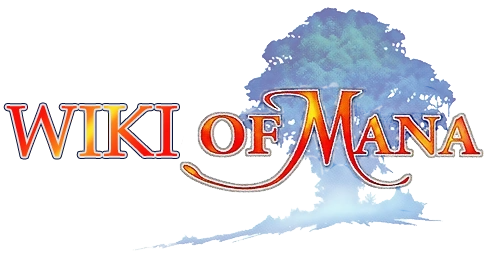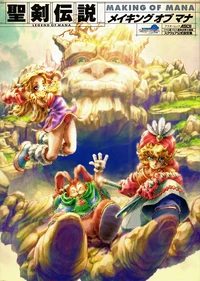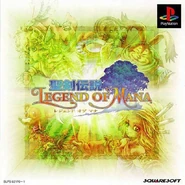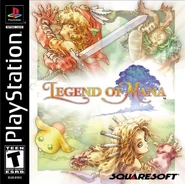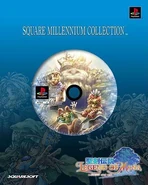Legend of Mana (聖剣伝説 レジェンド·オブ·マナ Seiken Densetsu Rejendo obu Mana) is the first Mana game not part of the main series.
While incorporating action role-playing game elements from the three games which preceded it, Legend of Mana has its own distinct style of gameplay. Most notably, it gives the player the ability to shape the game's world of Fa'Diel according to his or her desires, a system which was incorporated through the use of "artifacts," which are gained as the player progresses through the game. The player uses the artifacts to create different towns, dungeons, etc., called "Lands", to venture to and explore. This creates a non-linear gameplay, since the game is driven by a series of what would be considered side-quests in other games. Legend of Mana features three different plots which can occur simultaneously, and which do not necessarily need to be completed for the player to finish the game.
Legend of Mana was a financial success in Japan. While the game garnered considerable praise for its graphics and presentation, many critics and fans were turned off by the game's lack of a main storyline.
Gameplay
Legend of Mana features a unique "Land Make" system in which the player chooses plots of land to organize various locations within the game. The game world is divided into an isometric series of empty square plots of ground from which there are 36 possible in total. Depending on the Artifact (AF) which is placed on the plot, a different Land is generated on it. Each area placed on the map contains at least one quest within it, which upon completion rewards the player a new Artifact, and the process is repeated. Lands can be revisited, which is sometimes necessary to initiate more quests. Each Land has a certain level of strength in each Spirit of Mana on a points scale of zero (no presence) to three (strong presence). A high number of points on one square can add points to adjacent squares. The spirits—excluding Shade and Wisp—each represent a day on which the coordinating element becomes more powerful. Also, placing locations in given places affects the spirit rating of that particular area. Within each Land, players can explore numerous locations including towns, dungeons, and ruins. Many locations have non-player characters (NPCs) for interaction such as progressing the story or buying equipment. Other areas feature enemies and bosses with which the player can battle.
Legend of Mana features several role-playing elements as well. The main character and sidekicks each have their own set of numerical attributes including HP, strength and luck. These stats grow whenever the player gains a level, after meeting a set experience point requirement. By defeating enemies in battle, the player can collect experience point crystals that spill out. The main character can equip a variety of weapons, armors, and accessories. Weapons grant the player the ability to perform abilities in combat. Referred to as "STs" (Special Techs) in the game, these are the powerful attacks of the main characters and NPC sidekicks that can be used once the special move meter is filled. Each weapon has a set number of special attacks to learn, ranging from single-target to area to the full field. The player is able to customize his or her attack repertoire by assigning them to certain buttons.
Legend of Mana offers the option for the player to have two sidekicks—characters which are controlled either by the game's AI or by another player using the second controller. These sidekicks serve the purpose of making the game multiplayer to a degree by helping the main character while in battle, and also indirectly enhance the gaming experience if a human player takes control over the sidekick. Sidekicks consist of support characters, demi-humans, pets, and golems. The support characters include the Jumi Elazul and the merchant Niccolo. Demi-humans are monsters that have the ability to speak, and appear in certain areas, willing to join the player on his or her quest. Pets and golems can also accompany the protagonist, but cannot be controlled by a second player. Using a memory card, it is possible for two players to play together simultaneously using their main characters, but there are some limitations to this. The game also has an arena for two people to fight against each other in.
After certain quests are completed, Legend of Mana gives the player the option to delve into optional gameplay aspects centered around the hero or heroine's house. While weapons, armor, and accessories may be bought from stores, the player also has the option of forging or improving them using raw materials found throughout the game. Temporing occurs when any of the game's items is combined with the equipment, cumulatively raising or lowering its power or adding special effects. In the backyard of the players house is a small orchard, where the player is able to give some seeds to the orchard keeper, Trent, to grow fruit. What grows depends on the number of seeds previously given to him, the Mana levels of the Home Land and the kinds of seeds given him. The player can also unlock the monster corral, which can be used to raise pets via feeding them, letting them graze, or taking them out adventuring. They gain levels only if they are taken out with the hero, or if they are left to graze. They can also be raised using the Sony PocketStation, a peripheral only released in Japan. Finally, workshops can be used to create instruments and build golems. Instruments are created using elemental coins and armor, whilst utilizing the Mana power of a specific region. Different types of instruments, as well as different tunes, can be made depending on materials, as well as the melody and harmony gameplay mechanics of the workshop. Golems are built using weapons and armor as parts. The golem's attacks are determined by logic blocks, which are created in an urn in the workshop. It is done by combining two items, and the blocks are placed in a grid. All of the blocks must fit in, and for the golem to use attacks, the attack's respective logic blocks must be in the grid.
Plot
Setting
Legend of Mana is set in the fictional world of Fa'Diel. The Mana Tree, the giver of mana and life for the world, burned down nine centuries prior to the events of the game. A war erupted between faeries, human, and others seeking the scarce power of mana that was left. When the war concluded, the drained Mana Tree slept and the many lands of the world were stored in ancient artifacts. A hero, controlled by the player, is self-charged with restoring the world, and its mana, to its former self. The Lands of Fa'Diel are populated with a large number of different creatures, including humans, faeries, demons, the jewel-hearted Jumi race, plant-like Sproutlings and Flowerlings, miner bears called Dudbears, and shadowy beings of the Underworld known as Shadoles. Fa'Diel is also the home of a host of anthropomorphic animals and objects, as well as monsters from other Mana titles such as Rabites, Chobin Hoods, and Goblins.
Characters and story branches
The player can choose to be either a male or female silent protagonist. The gender has no actual bearing on gameplay, other than humorous comments made by NPCs regarding the fashion sense of the character. It is not really explained who either protagonist actually is or what their past was like before their Home became an Artifact, as their history and personality is meant to be determined by the player. A myriad of characters meet the hero or heroine during the course of the game's numerous quests; these characters join the player on more than one occasion and drive the game's split storyline, which is divided into three main plot branches. Each branch holds a series of related side-quests, which compose a part of Legend of Mana's story. Upon completion of any of these branches, the player is given the choice of finishing the game, even if quests from other branches have not yet been started or completed. There are 67 quests in total (excluding the final quest).
The first is the story of the Jumi, a dying race of people who have external jewel hearts which are considered valuable. The Jumi have apparently long been a persecuted people, as many magic characters in this game refer to them as "dirt"—a nasty comment on their jewel cores. This branch focuses on Elazul and Pearl, who are among the few survivors of the Jumi. Elazul is a Jumi Knight, and the mission of his life is to protect the Jumi Guardian Pearl at any cost, even in the face of the jewel hunter, Sandra.
The second is the story of Larc and Sierra, brother and sister dragoons who serve different dragon masters and fight on opposite sides of the same war for power. Larc, who serves the dragon Drakonis, invites the game's protagonist to help him in his quest to kill the other three dragon masters, so that his own master may have his power unlocked and rule the world. Sierra, a dragoon for Vadise the White Dragon, wants to stop Drakonis without hurting her brother Larc. In the end, Drakonis is defeated again, banished once more to the underworld.
The third is the complicated love story of four childhood friends: Matilda, Irwin, Daena and Escad. Irwin, a half-demon dissatisfied with the rules that society imposes on him which prevented him from being able to have a relationship with the holy leader Matilda, seeks to destroy the world in retribution, whilst Escad seeks to destroy him and Daena tries to act as a mediator between all parties. The conflict eventually escalates into a war between humans and faeries. Depending on the choices of the player, either Daena or Escad will die.
The remaining adventures concern the rest of the game's considerably large cast, including such stories as:
- The adventures of the unscrupulous rabbit merchant Niccolo
- The melodrama of the troubadour centaur Gilbert who seeks love in mostly the wrong places
- The sisterhood of the two sirens and a mermaid: Elle, Monique and Flameshe (a story often in relation to Gilbert's)
- Treasure hunting with boisterous pirate penguins and their walrus captain;
- The escapades of Diddle and Capella, two itinerant entertainers
- The story of Rachel, an angsty teenager who resents her parents' treatment of her
- The studious journey of the young rascal Bud, who wishes to meet all of the "Seven Wisdoms"
Regardless of which path the hero decides to take, the game's final story is called "Legend of Mana." It concerns the re-appearance of the Mana Tree. As such, this story seems more fitting with the series than any other, as the Mana Tree is a central icon of the Mana games. Once the hero scales the Mana Tree, he or she must fight the Mana Goddess. The tree, quoting the game, is "rotten with evil." Nonetheless, a Sproutling plants itself in the Mana Tree's rotten trunk after the Goddess falls. Calling upon the other Sproutlings, the Mana Tree is restored and what was wrong is righted.
See also List of characters
Development
Legend of Mana was directed by Mana series creator Koichi Ishii. It was produced by Akitoshi Kawazu, the director and producer of many games in Square's SaGa series. The game's character designs and illustrations were done by Shinichi Kameoka, who would later design characters for his company Brownie Brown, including the next game in the Mana series, Sword of Mana.
Legend of Mana was first announced by Square in March 1999 just before its debut at the Tokyo Game Show. The game was released in Japan with considerable hype, packaged with demos of Square's future releases Vagrant Story, Chrono Cross, Front Mission 3, and Threads of Fate.
Music
The game features music composed by Yoko Shimomura. She had previously composed for several Square games including Live A Live and Parasite Eve. A soundtrack was released under the name Seiken Densetsu: Legend of Mana OST in 1999 by DigiCube with a later reprint in 2004 by Square Enix. It includes Song of Mana, sung by Swedish vocalist Annika Ljungberg. The song was later made available on the Square Vocal Collection album in 2001. Four of the game's non-vocal tracks were released as part of Drammatica: The Very Best Works of Yoko Shimomura, an arranged album highlighting the composer's work. Shimomura carefully chose the songs to be included on the album based on their apparent popularity among fans and how suitable they are for orchestra. The game's title theme was also performed by the Australian Eminence Symphony Orchestra for its classical gaming music concert "A Night in Fantasia 2007"
| Seiken Densetsu: Legend of Mana OST tracklist | |
|---|---|
Disc 1 (63:47)
|
Disc 2 (66:50)
|
Merchandise
Upon the game's Japanese release, several promotional items were made available from Squaresoft. They include rabite plushies, a necklace, and lighters, among other products. As a promotion for Squaresoft's "Summer of Adventure" release schedule in 2000, those who preordered the game in North America were given a free music CD with select tracks from the game. As part of the Square Millennium Collection, Legend of Mana was re-released at a budget price and included a special music box and two character figurines. A companion book titled Seiken Densetsu: Legend of Mana Ultimania was released as part of Square's Ultimania series. It was published by DigiCube in 1999 and later reprinted by Square Enix in 2004 after the subsidiary's closing. Seiken Densetsu: Legend of Mana: Making of Mana, an artbook, was also published.
Shiro Amano, best known for his popular manga and novel adaptations of the Kingdom Hearts series, created a five-volume manga adaptation of Legend of Mana. The main character in the story is named Toto, a very brave yet foolish hero. Amano also included the female main character named Imu, though she was not involved in the first three volumes' story. The manga, published by Enterbrain, started in the year 2000 and ended in 2002.
Reception
Gallery
External links
| This page uses content from Wikipedia. The original article is at Legend of Mana. The list of authors can be seen in the page history. As with Wiki of Mana, the text of Wikipedia is available under the GNU Free Documentation License. |
